< Back to Climate Viticulture Newsletter
Hello, everyone!
This is the January 2021 issue of the Climate Viticulture Newsletter – a quick look at some timely climate topics relevant to winegrape growing in Arizona and New Mexico.
A Recap of December Temperature and Precipitation
Average temperatures last month were within 2°F of the 1981-2010 normal for much of the region (green, yellow, and light orange areas on map). Several locations near the Four Corners and southward along the state border, however, recorded temperatures 2°F to 5°F below normal (blue and purple areas on map), whereas some in east-central New Mexico measured them at 2°F to 3°F above normal (dark orange areas on map). These conditions are similar to those of December last year, when temperatures were within 2°F of normal for much of the region, except for eastern New Mexico where they were 2°F to 6°F above normal.
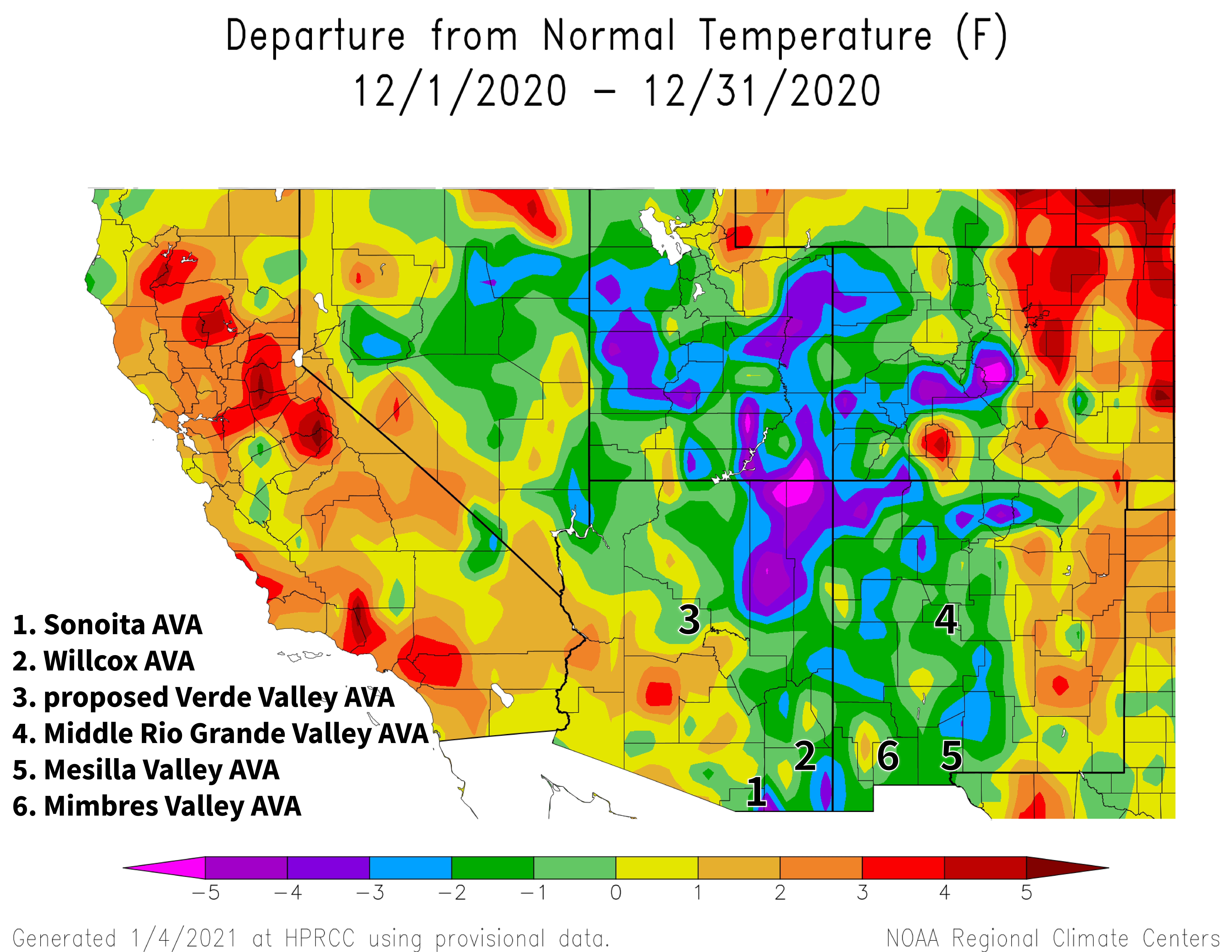
NOAA ACIS
Continuing the anticipated dry winter conditions due at least in part to the current La Niña event, monthly precipitation totals last month were less than 50% of the 1981-2010 normal for almost all of Arizona and much of New Mexico (red areas on map). For comparison, monthly precipitation totals in December 2019 were above normal for most of Arizona and the northern tier of New Mexico, while less than 50% of normal for the rest of the Land of Enchantment.
For much of Arizona and New Mexico, 2020 brought near-record to record warm and dry conditions. What this meant for viticulture was probably as complex, however, as the regional topography – features like elevation, slope, and aspect that influence temperatures and precipitation amounts. For vineyards in relatively warmer winegrape growing areas, for example, the past year may have presented challenges with heat stress and temperature ranges during ripening. For vineyards in relatively cooler areas, additional heat instead may have allowed fruit to ripen more fully in a typically shorter growing season.
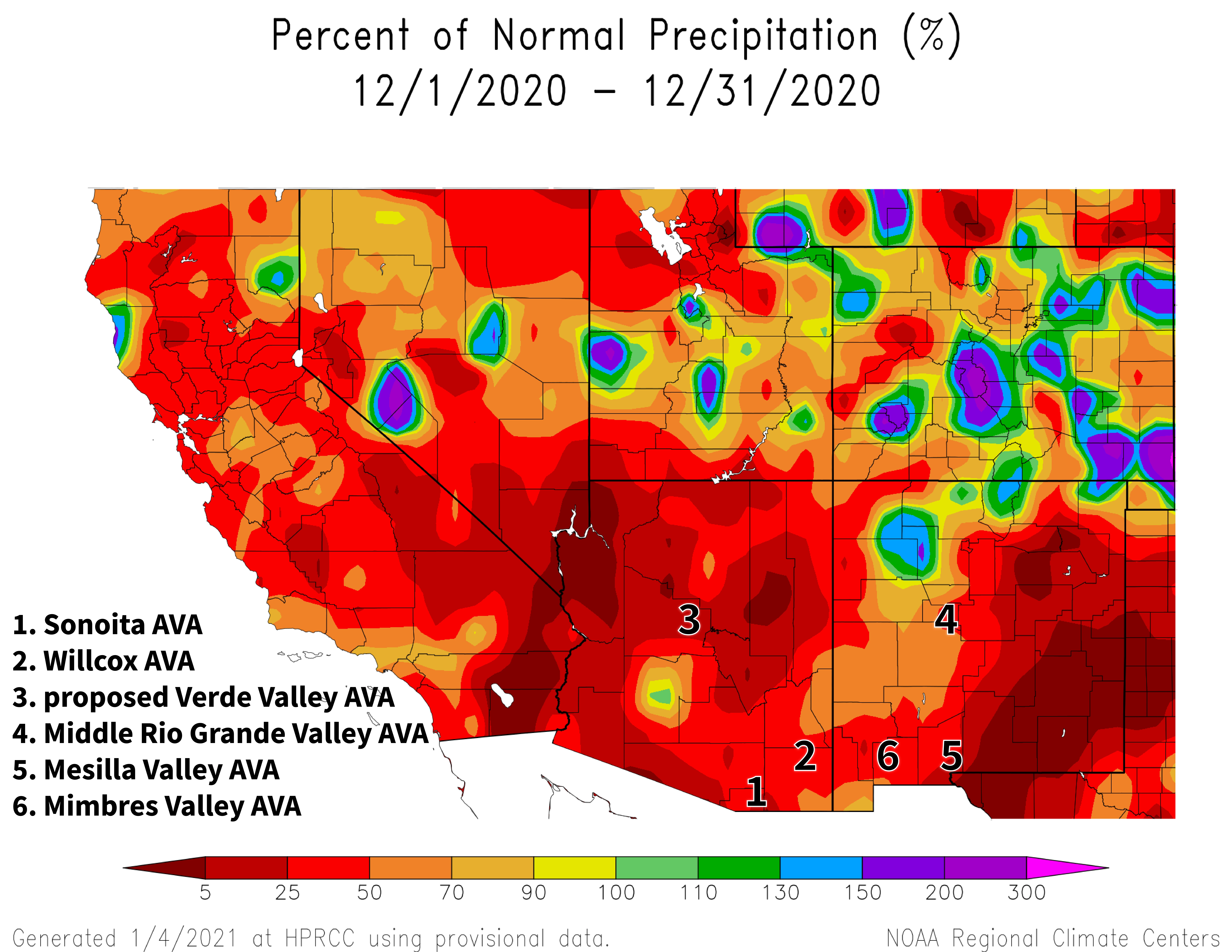
NOAA ACIS
The Outlook for January Temperature and Precipitation
There is a slight increase in chances for above-normal temperatures across eastern New Mexico (light orange area on map). Otherwise, there are equal chances for below-, near-, or above-normal temperatures for the region (white area on map). As a comparison, temperatures in January last year were within 2°F of normal for much of the region, except for parts of eastern New Mexico where temperatures were 2°F to 4°F above normal.
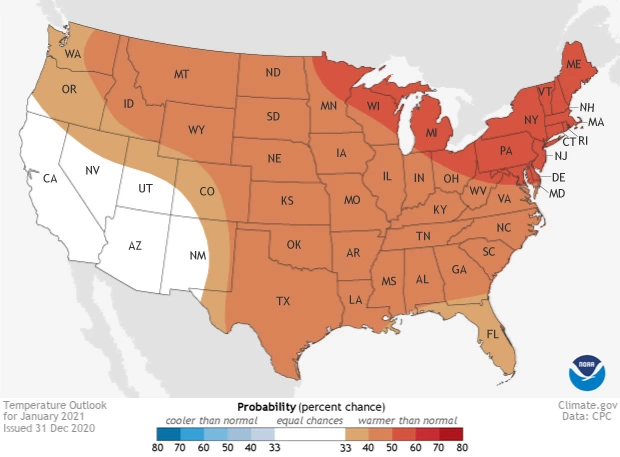
climate.gov
A slight increase in chances for above-normal precipitation exists for extreme northwestern Arizona (light aqua area on map), whereas a slight increase in chances for below-normal precipitation exists for southeastern Arizona and southern New Mexico (tan areas on map). Equal chances for below-, near-, or above-normal precipitation exist for the rest of the region (white areas on map). Monthly precipitation totals in January 2020 were below the 1981-2010 normal for almost the entire region.
With an elevated potential for dry conditions to continue, due in part to the ongoing La Niña event, soil moisture in the vineyard may need closer attention this winter relative to the past two. Adequate levels will help guard against damage from cold temperatures as well as delayed spring growth, which manifests as uneven bud break, stunted growth, reduced flower clusters, and other issues.
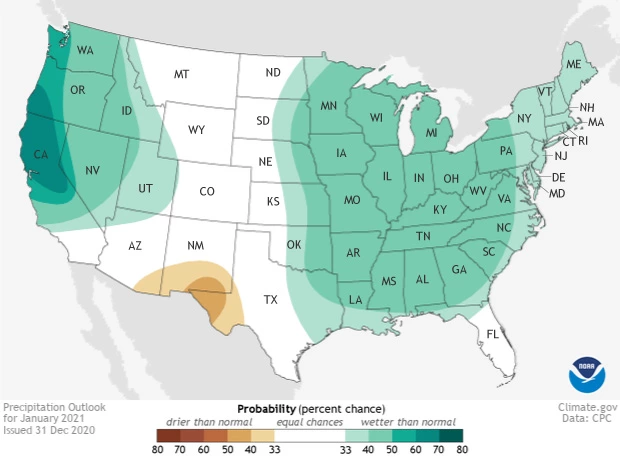
climate.gov
Climate Change and Viticulture: Growing Degree Days
To continue the new topical series on climate change and viticulture for the region, we look this month at growing degree days (GDDs) leading up to the start of the growing season. The Sonoita, Willcox, and proposed Verde Valley AVAs once again serve as examples.
We’ve plotted the historical observations and 1981-2010 normals of cumulative GDDs between January 1 and March 31 (thick dark gray and gray lines, respectively). These data overlay the range of cumulative GDDs as estimated for these areas by 32 models used to project plausible future climatic conditions. Observations for all three AVAs lie almost entirely within the ‘modeled history’ (gray shading), indicating that the models do well in representing past heat accumulation during this time of the year. Observations continue to occur within the band of ‘modeled future scenarios’ through 2020 (yellow, orange, and red shading1). We can expect cumulative GDDs to trend higher over the next 30 years, such that values below the 1981-2010 normals become less likely while values similar to and above those in 2015 and 2016 become more likely.
Heat accumulation during the first few months of the year plays a big part in determining the start of the growing season. As it trends higher, its influence will be to have bud break occur earlier. A proximate implication of this advance in vine phenology is a potential change in spring freeze risk, something that also is dependent on any concurrent trends in the occurrence of freezing temperatures. A distant implication of advanced phenology at the beginning of the growing season is that subsequent growth stages, like veraison, also occur earlier in the year. This may lead to grapes ripening under different temperature conditions that can affect aspects of fruit quality, like sugar and acidity levels.
1 ‘Modeled future scenarios’ are based on two different scenarios of future greenhouse-gas emissions. RCP4.5 (yellow shading) corresponds to a slower increase of global carbon emissions to 2050, relative to RCP8.5 (red shading). Global climate models use these scenarios to drive plausible trajectories of future climatic conditions. Orange shading represents the overlap of the ranges of cumulative GDDs based on the scenarios. RCP is an abbreviation for Representative Concentration Pathway.
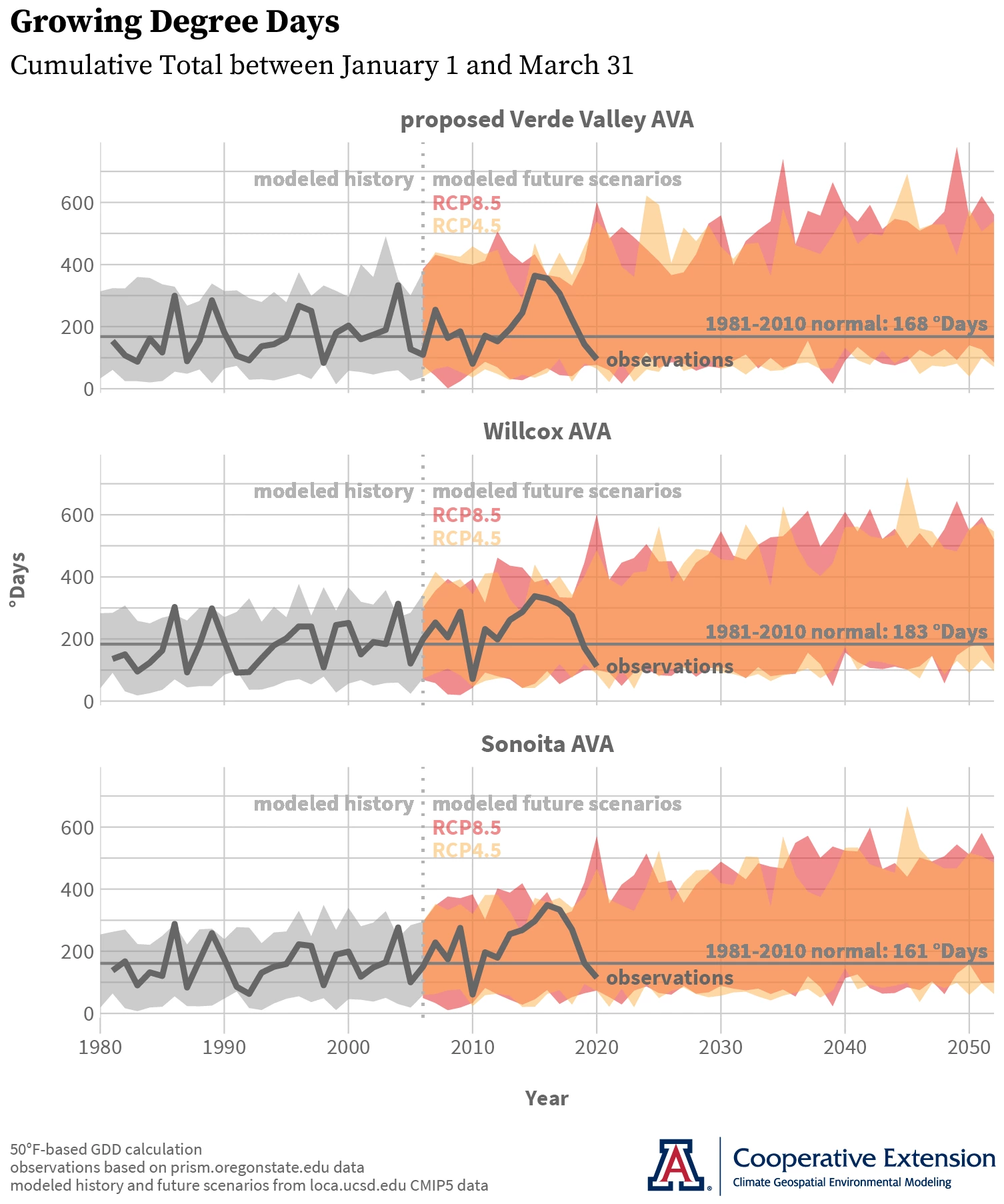
Jeremy Weiss
La Niña conditions persisted over the past month and current forecasts still show a 95% chance that this event will last through the winter before likely dissipating thereafter. With current forecasts, dry conditions in the region over the coming months are more likely but not heavily favored.
A recent donation of 40 acres near Willcox plus recent funding from the USDA-AZDA Specialty Crop Block Grant program are some of the first steps of a newly formed public-private collaboration towards a Viticulture Center of Research (VCOR) that will help support winegrape growing in Arizona. The funding will provide resources to convene the state viticulture industry and its supporters in the latter half of 2021 to determine common interests and develop plans for moving the VCOR project forward. Another first step is to gather letters of support that demonstrate backing of the VCOR project from the Arizona viticulture industry to relevant leaders in the University of Arizona. To learn more about the VCOR project and how to contribute a letter of support, please contact Joshua Sherman, commercial horticulture agent with University of Arizona Cooperative Extension.
Undergraduate students in the College of Agriculture and Life Sciences at the University of Arizona are looking for internships with businesses and companies in the viticulture and winery industry during 2021. Please contact Danielle Buhrow, Senior Academic Advisor and Graduate Program Coordinator in the Department of Agricultural and Resource Economics, for more information.
For those of you in southeastern Arizona, Cooperative Extension manages an email listserv in coordination with the Tucson forecast office of the National Weather Service to provide information in the days leading up to agriculturally important events, like winter storms and cold-air outbreaks. Please contact us if you'd like to sign up.
Please feel free to give us feedback on this issue of the Climate Viticulture Newsletter, suggestions on what to include more or less often, and ideas for new topics.
Did someone forward you this newsletter? Please contact us to subscribe.
Have a wonderful start to the new year!
With support from:




